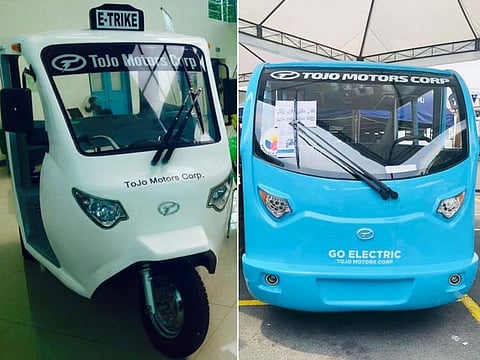Should Tesla, or BYD, buy Tojo of the Philippines?
E-trike maker leading the charge for electric transport in the Asian country

Manila: Tojo Motors Corp, a Filipino-owned maker of electric buses and tricycles, says it has enough orders to justify a production ramp.
Could the likes of Tesla, BYD, Zeekr, Warrent Buffett, a wealth fund, or a venture capitalist find it a good opportunity to hop in?
Tojo, based in Santa Rosa, Laguna (about 52 km south of capital Manila), currently employs 70 people making electric 'Tuktuks', mini-cars and mini-buses.
Founded in 2013, it is one of the few bold first-movers in the local EV space. Over the last 11 years, it has not only managed to survive but also thrive at the lower-end of the last-mile, zero-emissions public transport market.
Tojo’s EVs work and have proven to be road-worthy. The company makes several e-trike models, for 100 per cent domestic customers.
They have emerged as a practical, low-cost leader. They're not as stylish or tech-loaded like Teslas or BYDs, but Tojo units provide a cost-effective alternative to gas-powered trikes and jeepneys that for decades have ruled local roads.
Tojo’s six-seater Lawin 2 e-trike (price: 475,000 pesos or $8,145) and 14-seater Haribon e-buses are popular due to cost, performance and lower maintenance.
The Hagibis 6-seater is driven by a 5KW motor, a lithium battery, a 500A controller, R13 tyres and a total vehicle weight of 580kg.
The company is 100 per cent Filipino owned, and is currently not listed, so its books are not public.
Limited resources
Now, the Tojo faces a major challenge: scaling production.
Given its limited resources, though, Tojo can’t scale fast enough.
With close to 1,000 local orders of EV units, as of (October 24) and a limited production rate of 150 units a month – its factory would take at least 7 months to fulfill current orders.
Deliveries
Ralph Legaspi, Tojo Motors CEO, told local media they have firm orders for 576 units for the transport cooperative servicing Makati-Manila area, 150 units for Novaliches-Malinta route, 120 units for Blumentritt-Baclaran route, and 120 units in Calamba area.
Tojo units also serve cities outside Manila, as well as the world-famous resort island of Boracay.
Legaspi said his company needs additional funds in order to ramp production and ease public transport beset by rising fuel prices and CO2 emissions.
Local demand driver
A key demand driver: the government’s “PUV Modernization Program”, which incentivises electric vehicles.
The company is currently collaborating with local governments to eventually replace aging jeepneys and tricycles with cleaner alternatives.
Tojo trikes and e-buses are inexpensive, basic models, designed to meet local requirements for public transport.
Electric advantage
There’s room for growth: The recent floods have proven that fossil-fuel based transportation can grind to a halt due to lack of imported petrol.
Electricity, on the other hand, can be generated locally by solar, wind, hydro and geothermal power.
The e-trikes has a significant total addressable market locally: there are currently up to 4.5 million registered petrol-powered trikes, a ubiquitous form of last-mile transport across the archipelago.
Low-cost EV models
Tojo's lineup includes purpose-built models: The Lawin 2 e-trike, for instance, is designed with a high seating capacity for public transportation, supporting up to six passengers, including the driver.
Another model, the Haribon e-jeepney, provides a larger capacity to serve busier routes and often operates in compliance with local government public utility vehicle standards.
They’re no comparison to Tesla’s S, 3, X, Y, Cybertrucks and Semis, or BYD Seal, Atto or Han models.
Batteries
Tojo has managed to engineer its models with robust batteries and lightweight bodies, which improve their overall energy efficiency and longevity, and cost efficiency.
An e-trike typically costs only 1-2 per pesos kilometer in electricity, compared to the higher costs of gasoline, making it a viable choice for drivers and operators aiming to save on fuel expenses
Partnerships
The company has also expanded its reach — partnering with electric charging providers to enhancing the usability and accessibility of its vehicles. Production efficiency, and lower battery costs could further see unit prices go down..
Tojo’s Hagibis 6-seater is driven by a 5KW motor, a lithium battery, a 500A controller, R13 tyres and a total vehicle weight of 580kg.
Given its 11-year run, Tojo has clocked up some knowhow on low-cost EV solutions for a developing market. Tesla’s or BYD’s unmatched tech, manufacturing, financial resources and global market reach, could further energise this segment, which they have so far ignored in these parts.
I have to increase the production. We are always looking for funders to invest, because our target is to produce more than 150 (units) per month.Ralph Legaspi, Tojo Motors CEO
Legaspi did not mention how much he needs.
“I have to increase the production. We are always looking for funders to invest, because our target is to produce more than 150 (units) per month,” Legazpi was quoted as saying.
Perhaps the Maharlika Fund could jump in?
He believes that by bolstering partnerships and keeping its focus, Tojo would be able to spread its wings enough to become a viable and cost-effective public e-transport solution provider.
Tojo's production run rate (150 units per month) is nowhere near Tesla's (229 vehicles per hour) or BYD's (197 per hour).
Given that Tesla's strategy is to enter at the high end of the market, where customers are prepared to pay a premium, and then drive down market as fast as possible, support for Tojo on the lower end could give flesh to a common goal: compelling EVs for all.
Sign up for the Daily Briefing
Get the latest news and updates straight to your inbox



